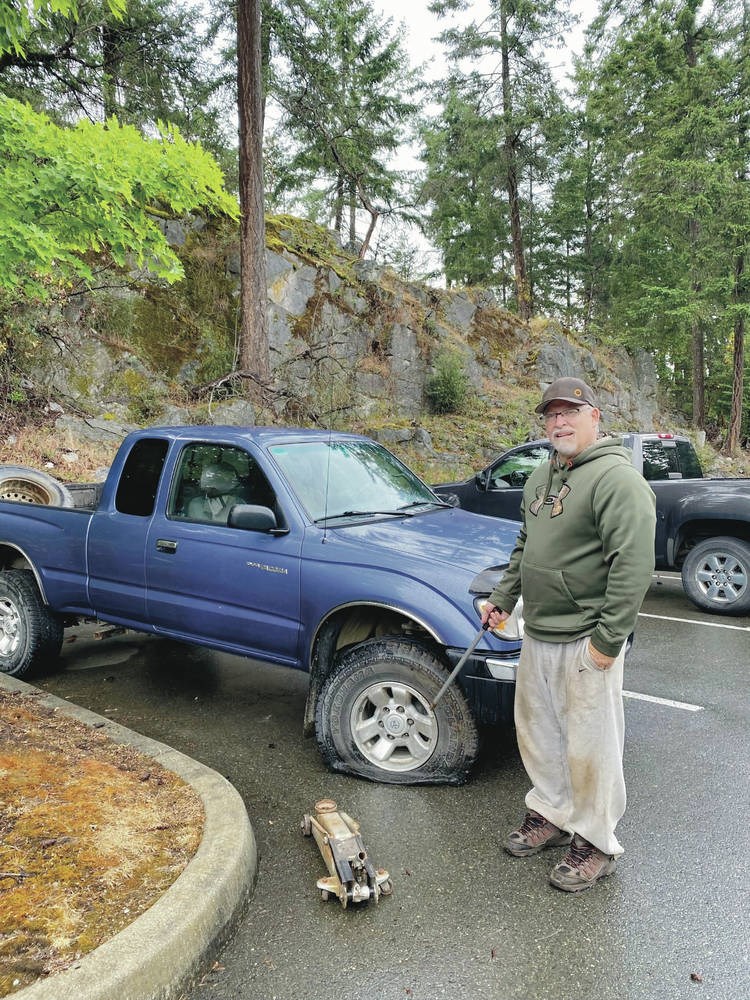A Nanoose Bay man had a close call this past week after the vehicle he was sitting in was struck by lightning — just days before National Lightning Safety Awareness Week is set to begin.
On Wednesday afternoon, a slow-moving thunderstorm passed through the Nanoose Bay area, with 41 lightning flashes recorded by Environment Canada. Around half were harmless cloud-to-cloud flashes, but about 20 struck the ground, including one that hit a tree on the edge of a parking lot at Fairwinds Wellness Club.
Terry Mazzei,63, had just parked and was about to get out of his Toyota Tacoma compact truck when a bolt of lightning enveloped it.
While no place is safe outdoors during a thunderstorm, a metal-framed vehicle that’s not a convertible is a good place to be, as lightning will travel around the outside surface, essentially protecting people in the vehicle from the electrical shock in what is called the Faraday Cage effect.
Fortunately, Mazzei wasn’t in contact with the steering wheel, radio knob or door handle, which would have conducted up to 12 kiloamperes of peak electrical current a lightning strike produces.
“He had just taken the key out of the ignition,” said Wendy Mazzei, his wife. “He said there was a blast of light and explosion of sound, which left a ringing in his ears, but he was otherwise unhurt.”
The blast blew out the truck’s right front tire.
Research has shown that a lightning strike that hits the ground can be fatal to someone within 10 metres, and cause injuries up to 30 metres from where it strikes.
The couple would like to believe that Terry’s late father, who passed away in 2016, was still looking out for his son. The truck was his dad’s and Terry keeps a picture of him in the sun visor.
Armel Castellan, warning preparedness meteorologist at Environment Canada, said the incident is a timely reminder of the danger lightning poses.
Wednesday’s storm and the number of strikes it produced were tracked by the Canadian Lightning Detection Network. Established in 1998, the network consists of 81 lightning sensors across Canada.
Sensors determine the strength, polarity (positive or negative charge) and time of lightning strikes, all from the electromagnetic pulse of the lightning.
The data is accessible to the public via Environment and Natural Resources Canada’s Canadian Lightning Danger Map. The map plots areas at the greatest risk of being struck by lightning in the next 10 minutes.
The site records cloud-to-ground lightning strikes and a small percentage of cloud-to-cloud lightning.
The information is valuable with summer approaching and more and more people venturing outdoors.
“The safest place when lightning strikes is to be inside a house which has plumbing and wiring, but you can’t always do that when you are camping or watching a soccer game,” said Castellan.
National Lightning Safety Awareness Week, set for June 20-26, is a reminder for people to be aware of their surroundings — if a storm is approaching, for example — and to know in advance how to get to safety, Castellan said.
Canada averages about two million lightning strikes each year, killing three and injuring between 100 and 150 people, mainly in the summer. Risk varies from place to place.
The Interior of British Columbia has a relatively low lightning density, but it’s more pronounced east of the Rocky Mountains continental divide.
On Vancouver Island, Nanaimo recorded 1,300 cloud-to-ground lightning flashes between 1999 and 2018. Victoria in the same period recorded only 686.
The B.C. city you may want to avoid if you don’t like lightning is Cranbrook, which saw 14,680 flashes. At the other end of the scale, Prince Rupert only reported 152 flashes in the same 19-year time frame.
About 90 per cent of deaths and 80 per cent of injuries from lightning occur during June, July and August when people are enjoying the outdoors. Campers and hikers are among those most commonly affected by lightning, often caught in open areas or when taking shelter under trees.
“Our advice is: ‘When thunder roars, move indoors,’ ” said Castellan. “Find a building with wiring and plumbing or an all-metal vehicle and stay inside for 30 minutes after the last rumble.”
Reasoning that a person is more likely to be struck by lightning than win a lottery, Terry Mazzei purchased a Lotto Max ticket the day after the lightning strike.
While wishing him luck, Castellan didn’t think the purchase was necessary.
“Given the circumstances, I would say that he has already won the lottery.”
For more information, go to lightningsafetycouncil.org.
parrais@timescolonist.com



